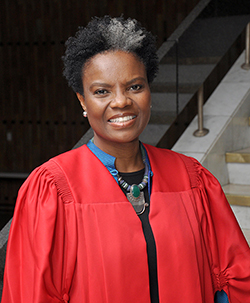
Prof Alcinda Honwana |
"Enough is Enough!": Youth Protests and Political Change in Africa (speech)
The Centre for Africa Studies at the UFS hosted an interdisciplinary project on the Bloemfontein Campus from 20-22 May 2015.
The project, entitled Contemporary Modes of Othering: Its Perpetuation and Resistance, looked at different perspectives, representations, and art forms of otherness, how it is perceived, and how it is resisted.
The annual Africa Day Memorial Lecture was held on Thursday evening 21 May 2015 at the CR Swart Auditorium. Guest speaker Prof Alcinda Honwana addressed the subject of ‘Youth Protests and Political Change in Africa’.
“Youth now seem able to display what they don’t want, rather than what they do want,” Honwana said in her opening remarks. “Thus, we see the young driven to the streets to protest against regimes.”
Honwana shed some light on recent examples of youth protests in Africa that have enjoyed global attention. Looking at the protests in Tunisia (2010), Egypt (2011), Senegal (2012), and Burkina Faso (2014), it is clear that these events in northern and western Africa have inspired others globally. Yet, Honwana stated that, despite these protests, no social economic change has been seen, and has left dissatisfaction with new governments as well.
“Once regimes fall… young activists find themselves more divided, it seems…
“Which leaves the question: Will street protests remain young people’s main mechanism to avert those in power?”
Background on Prof Alcinda Honwana:
Alcinda Honwana is currently Visiting Professor of Anthropology and International Development at the Open University (UK). She was chair in International Development at the Open University, and taught Anthropology at the University Eduardo Mondlane in Maputo, the University of Cape Town in South Africa, and the New School for Social Research in New York. She was programme director at the Social Science Research Council in New York, and worked for the United Nations Office for Children and Armed Conflict. Honwana has written extensively on the links between political conflict and culture, and on the impact of violent conflict on children and youth, conducting research in Mozambique, the Democratic Republic of the Congo, Angola, Colombia, and Sri Lanka. Her latest work has been on youth and social change in Africa, focusing on Mozambique, Senegal, South Africa, and Tunisia.
Honwana’s latest books include:
• Youth and Revolution in Tunisia (2013);
• Time of Youth: Work, Social Change, and Politics in Africa (2012);
• Child Soldiers in Africa (2006);
• Makers and Breakers: Children and Youth in Postcolonial Africa (2005, co-edited).
Honwana was awarded the prestigious Prince Claus Chair for Development and Equity in the Netherlands in 2007.